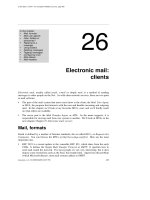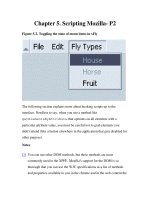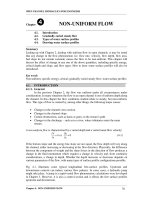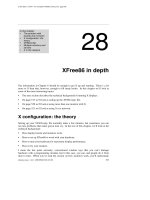Chapter 5_The Vector Space Rn.ppt
Bạn đang xem bản rút gọn của tài liệu. Xem và tải ngay bản đầy đủ của tài liệu tại đây (457.88 KB, 54 trang )
Chapter 5
The vector space R
n
Contents
5.1 Subspaces and Spanning sets
5.2 Independence and Dimension
5.3 Orthogonality
5.4 Rank of a Matrix
Subspace of Rn
• n
Definition of subspace of Rn.
U
•
Let Ø≠U be a subset of Rn
••
•
U is called a subspace of Rn if:
•
S1. The zero vector 0 is in U
vector zero vector
S2. If X,Y are in U then X+Y is in U
S3. If X is in U then aX is in U for all real number a.
Ex1. U={(a,a,0)|aR} is a subspace of R3
n
the zero vector of R3, (0,0,0)U
(a,a,0), (b,b,0)U(a,a,0)+(b,b,0)=(a+b,a+b,0)U
If (a,a,0) U and k R, then k(a,a,0)=(ka,ka,0)U
• • •
• ••
U•
•
Ex2. U={(a,b,1): a,b R} is not a subspace of R3
(0,0,0)U U is not a subspace
Ex3. U={(a,|a|,0)|a R} is not a subspace of R3
(-1,|-1|,0), (1,|1|,0)U but (0,2,0) U U is not a subspace
X
aX
X+Y
Y
Examples- do your self
V={[0 a 0]T in 3: a Z}
Nhận xét: các trường hợp sau
không là không gian vector con
U={[a 7 3a]T in 3: aR}
có thành phần khác khơng
có hệ số bậc cao hoặc tích
W={[5a b a-b]T in 3: a,bR}
có dấu | |
T
Q={[a b |a+b|] : a }
có a và a+1 chẳng hạn
H={[a b ab]T: a,b }
P={(x,y,z)| x-2y+z=0 and 2x-y+3z=0}. P is called the solution
space of the system x-2y+z=0 and 2x-y+3z=0.
Note
• A subspace either has only one or infinite
many vectors
• Example, {0} has only vector
• If a subspace U has nonzero vector X then aX
is also in U (by S3). Then U has infinite many
vector
Null space and image space of a matrix
A is an mxn matrix, if X is nx1 matrix then AX is mx1 matrix
nullA = {X in Rn: AX=0}
m
imA = {AX: X is in Rn}
A
nullA
•
imA
n
nullA ={X Rn:AX=0} is a subspace of Rn:
A.0=00nullA
X,Y nullA AX=0, AY=0
A(X+Y)=AX+AY=0 (X+Y) nullA
X nullA, a R AX=0 A(aX)=a(AX)=0
aXnullA
zero vector
imA ={AX:X Rn}is a subspace of Rm:
0=A.00imA
AX,AY imA AX+AY=A(X+Y)=AZ
AX+AY imA
AX imA, a R a(AX)=A(aX)=AZ
a(AX)imA
Null space nullA={X:AX=0}
1 1 0
For example, A
2
3
1
23
x
x
x
x
0 1 1 0 0
nullA y : A y y :
y
0
2 3 1
0
z
z
z
z
x
t
x y 0
y :
t : t
z 2 x 3 y z 0 5t
Eigenspaces (không gian riêng)
Suppose A is an nxn matrix and λ is an eigenvalue of A
Eλ(A)={X: AX=λX} is an subspace of Rn
For example,
x 3
1
3 1
A
c
x
det
xI
A
x 3 x 2
A
0
x 2
0 2
c A x 0 x 3 x 2
0 1 0
0 1 0
t
x 3 :
X (or X= t ,0 )
0
0 5 0
0 0 0
5 1 0
t
x 2 :
X
0
0
0
5
t
E 3 X : AX 3 X t ,0 : t
E2 X : AX 2 X t , 5t : t
Các không gian riêng
ứng với GTR
Spanning sets (hệ sinh)
Y=k1X1+k2X2+…+knXn is called a linear combination of the vectors X1,X2,…,Xn
The set of all linear combinations of the the vectors X1,X2,…,Xn is called the
span of these vectors, denoted by span{X1,X2,…,Xn }.
This means, span{X1,X2,…,Xn} = {k1X1+k2X2+…+knXn :kiR is arbitrary}
span{X1,X2,…,Xn} is a subspace of Rn.
For example, span{(1,0,1),(0,1,1)}={a(1,0,1)+b(0,1,1) :a,bR}.
And we have (1,2,3)span{(1,0,1),(0,1,1)} because (1,2,3)= 1(1,0,1)+
2(0,1,1).
(2,3,2)span{(1,0,1),(0,1,1)} because (2,3,2)≠a(1,0,1)+b(0,1,1) for all a,b.
Nếu U=span{X,Y} ta nói U là KG được sinh ra bởi {X,Y} hay hệ {X,Y} sinh ra
KG U. Khi đó, U chứa tất cả các vector có dạng aX+bY với a, b là các số thực
tùy ý.
vector Zspan{X,Y} khi và chỉ khi có các số thực a,b sao cho Z=aX+bY hay hệ
pt Z=aX+bY có nghiệm a,b.
Ta cũng nói Z là một tổ hợp tuyến tính (linear combination) của X,Y khi
Z=aX+bY hay Zspan{X,Y}.
Examples
If x=(1,3,-5) is expressed as a linear combination of the vectors v 1 = (1, 1,
1); v2 =(1,1,-1); v3 = (1, 0, 2); then the coefficient of v3 is:
A. 2
B. 3
C. -2
D. 1
E. 0
x is expressed as a linear combination of v1, v2, v3 means x=av1+bv2+cv3 for
some a,b,c and c is called the coefficient of v3.
the system is
1 1 1 1
1 1 1 1
1 1 1 1
a+b+c = 1 1 1 0 3
a =1
0 -2 1 -6
0 0 -1 2
a+b
= 3 1 -1 2 -5
b =2
0 0 -1 2
0 -2 1 -6
a – b +2c =-5
c =-2
Which of the vectors below is a linear combination of u=(1,1,2); v=(2,3,5)?
A. (0,1,1)
B. (1,1,0)
C. (1,1,1)
D. (1,0,1)
E. (0,0,1)
Có thể giải bằng biến đổi sơ cấp trên ma trận chứa các vector cột như sau:
u
v
A
B
C
D
E
u
v
A
B
C
D
E
u
v
A
B
C
D
E
2
0
1
1
1
0
-2
0
1
1
1
0
-2
0
1
1
1
0
1
3
1
1
1
0
0
0
1
0
0
-1
0
0
1
0
0
-1
0
2
5
1
0
1
1
1
0
1
1
-2
-1
-1
1
0
0
0
-2
-1
0
1
Theorem
U=span{X1,X2,…,Xn} is in Rn and U is a subspace of
Rn
If W is a subspace of Rn such that Xi are in W
then
U W
•
U span x1 , x2 , x3 , x4 , x5
• ••
•
W
4
Linear Independence (sự độc lập tuyến tính)
A set of vectors in Rm {X1,X2,…,Xn } is called linearly independent
(độc lập tuyến tính)
if
t1X1+t2X2+…+tnXn=0 t1=t2=…=tn=0 only
numbers in R
vectors in Rm
Ex1. The set {[1 -1]T, [2 3]T}R2 is called linearly independent since t1[1 -]T + t2[2
3]T = [0 0]T follows t1=t2=0.
Ex2. A set of vectors that containing zero vector never linearly independent.
Ex3. The set {(0,1,1), (1,-1,0), (1,0,1)} is not linearly independent because the
system t1(0,1,1)+t2(1,-1,0)+t3(1,0,1)=(0,0,0) has one solution t1=-1, t2=-1, t3=1
Examples
Show that {(1,1,0);(0,1,1);(1,0,1)} is linearly independent in R 3
t1 1,1,0 t2 0,1,1 t3 1,0,1 0,0,0
... t1 t2 t3 0
t1 1,1,0 t2 0,1,1 t3 1,0,1 0,0,0
1
1t1 0t2 1t3 0
1t1 1t2 0t3 0 1
0t 1t 1t 0
0
2
3
1
t1 t2
0 1 0
1 0 1 0
1 0 1 0
1 0 0 0 1 1 0 0 1 1 0
0 0 2 0
0 0 1 0
1 1 0
t3 0 independent
Fast way to determine a set of vectors is independent or not:
independent Number of leading 1s = member of vectors
More ex. {(1,0,-2), (2,1,0),
(0,1,5), (-1,1,0)} is not linearly
independent (number of
leading 1s = member of
vectors)
1
2
0
-1
1
2
0
-1
1
2
0
-1
0
1
1
1
0
1
1
1
0
1
1
1
-2
0
5
0
0
4
5
2
0
0
1
-2
Examples – do your self
Determine whether each the following sets is linearly
independent or linearly dependent.
{(-1,2,0)}
{(0,0,0); (1,2,3); (-3,0,1)}
{(1,1,-1); (-1,1,1); (1,-1,1)}
{(-2,3,4,1); (4,-1,5,0); (-2,1,0,3)}
{(1,1,0); (-2,3,1); (5,0,1); (-1,0,2)}
{X-Y+Z,3X+Z,X+Y-Z}, where {X,Y,Z} is an independent set of
vectors. (see below)
1
3
1
3
1
3
1
3
1
3
1
-1
0
1
0
3
2
0
1
0
1
0
1
1
1
-1
0
-2
-2
0
3
2
0
0
-1
0
0
independent
Fundamental Theorem
Theorem. Let U be a subspace of Rn is spanned by m vectors,
if U contains k linearly independent vectors, then k≤m
This implies if k>m, then the set of k vectors is always linear
dependence.
For example, Let U be the space spanned by {(1,0,1), (0,1,1)} and S={(1,0,1), (0,-1,1), (2,-1,3)} U. Then, S is not
linearly independent (m=2, k=3).
Basis and dimension (cơ sở và chiều của KG)
Definition of basis: Suppose U is a subspace of Rn, a set {X1,X2,
…,Xk} is called a basis of U if U=span{X1,X2,…,Xk} and {X1,X2,
…,Xk} is linear independence
Ex1. Let U={(a,-a)|aR}. Then U is a subspace of R2. Consider the set B={(1,1)}. B is linearly independent and U={(a,-a):aR}={a(1,-1): aR } =span{(1,1)}. So, B is a basis of U.
Note that B’={(-1,1)} is also a basis of U.
But {(1,1)} is not a basis of U because U can not be spanned by {(1,1)}
Ex2. Given that V=span{(1,1,1), (1,-1,0), (0,2,1)}. Then, B={(1,1,1), (1,-1,0),
(0,2,1)} is not linearly independent, because (0,2,1)=(1,1,1) – (1,-1,0)B is
not a basis of V.
Consider B’={(1,1,1), (1,-1,0)}. B’ is linearly independent and all vectors in
V are spanned by B’ because a(1,1,1)+ b(1,-1,0)+ c(0,2,1) =a(1,1,1)+ b(1,1,0)+ c(1,1,1) –c(1,-1,0) = (a+c)(1,1,1)+(b-c)(1,-1,0). So, B’ is a basis of V.
Some important theorems
Theorem 1. The following are equivalence for an nxn matrix A.
A is invertible.
the columns of A are linearly independent.
the columns of A span Rn.
the rows of A are linearly independent.
the rows of A span the set of all 1xn rows.
Theorem 2. (Invariance theorem). If {a1,a2,..,am} and {b1,b2,…,bk} are bases of a
subspace U of Rn, then m=k. In this case, m=k is called dimension of U and we write
dimU=m.
Ex1. Let U={(a,-a)|aR} be a subspace of R2. Then, B={(1,-1)} is a basis of U and
B’={(-1,1)} is also a basis of U. In this case, dimU=1.
Ex2. {(1,0), (0,1)} is a basis of R2 and {(1,-2), (2,0)} is also a basis of R2. But {(1,0), (1,1), (1,1)} is not a basis of R2. We have dimR2=2.
The basis {(1,0), (0,1)} is called standard basis of R2.
Ex3. Which of the following is a basis of R3?
{(1,0,1), (0,0,1)}
3
Nhận
xét:
trong
R
, mọi
{(2,1,0), (-1,0,1), (1,0,1), (0,-1,1)}
tập có 3 vector độc lập
{(0,1), (1,0)}
đều là cơ sở.
None of the others
Some important theorems
Theorem 3. Let U≠0 be a subspace of Rn. Then:
U has a basis and dimUn.
Any independent set of U can be enlarged (by adding vectors) to a basis of U.
If B spans U, then B can be cut down (by deleting vectors) to a basis of U.
Ex1. Let U=span{(1,1,1), (1,0,1), (1,-2,1)} be a subspace of R 3. This means, B=
{(1,1,1), (1,0,1), (1,-2,1)} spans U.
U has a basis and dimU3,
B can be cut down to a basis of U: {(1,0,1), (1,1,1)} is a basis of U, dimU=2
construct a basis for U: {(1,0,1)} {(1,0,1), (1,1,1)}.
1
1
1
1
1
1
1
1
1
1
0
-2
0
-1
-3
0
1
3
1
1
1
0
0
0
0
0
0
Cũng có thể chọn 2
vector 1 và 3, hoặc 2
và 3 làm cơ sở
Theorem 4. Let U be a subspace of Rn and B={X1,X2,…,Xm}U, where dimU=m.
Then B is independent if and only if B spans U.
Theorem 5. Let UV be subspaces of Rn. Then:
dimU dimV.
If dimU=dimV, then U=V.
Exercises
Determine whether U is a subspace of R3.
U={[0 a b]T: a,b R}
U={[0 1 s]T:s R}
U={[a b a+1] T:a,b R}
U={[a b a2]T: a, b R}
1
0
2
0
2
0
1 m
0
1
m
1
1
0
1
-1
1
0
2
0
m
0
0
-1-m
Nhận xét: khơng là subspace khi
có hằng số khác 0
có hai hệ số chênh lệch 1 hằng
số
có bậc lớn hơn 1
Find all m such that the set {(2,m,1),(1,0,1),(0,1,1)} is linearly
independent.
m≠-1
m=-1 only
Independent số = số vector
m=0 only
m≠0
None of the others
A basis for the subspace U={[a b a-b]T: a,b R} is…
a. {[1 0 1]T, [0 1 -1]T}
b. {[1 1 0]T}
c. {[1 0 1]T, [-1 0 -1]T, [0 1 -1]T}
d. None of the others.
Nhận xét:
U phụ thuộc 2 tham số nên
dimU=2 và mọi cơ sở đều phải có
đúng 2 vector độc lập tuyến
tínhchỉ có thể là a hoặc d.
kiểm tra a: độc lập và sinh ra U
Exercises
The dimension of the subspace U=span{(-2, 0, 3),
(1, 2, -1),(-2, 8, 5),(-1, 2, 2)} is…
a. 2
1 -2 -1 -2
-2 -1 -2
b. 4
2 8 2 0
0 12 4
4
c. 3
d. 1
-1 5 2 3
0
3
1
1
w span{u,v} means w=au+bv
{u,v,w} is not independent
lưu ý cũng khơng có gì chắc
chắn {u,v} độc lập nên dimU2
khơng thể là b vì dimUdimR3=3
kiểm tra bằng biến đổi sơ cấp
-2
-1
0
1/3 1/3
0
0
0
-2
}có đúng hai
0
Let u and v be vectors in R3 and w span{u,v}. Then …
a. {u,v,w} is linearly dependent.
b. {u,v,w} is linearly independent.
c. {u,v,w} is a basis of R3
d. the subspace is spanned by {u,v,w} has the dimension 3.
Let {u,v,w,z} be independent. Then …. is also
independent.
1 1 0
a. {u,v+w,z}
1 0 0
b. {u,v,v-z-u,z}
0 -1 0
c. {u+v,u-w,z, v+z+w}
d. {u,v,w,u-v+w}
0 0 1
0
1
0
0
1
0
0
1
0
-1
0
1
0
0
-1
1
0
-1
0
1
0
0
1
1
0
0
1
1
0
0
0
0
{v-z-u,v,z,u} hiển nhiên phụ thuộc
kiểm tra bằng biến đổi sơ cấp, ví dụ xét c, hệ số của các vector được đặt thành cột theo trật tự u,v,w,z
chỉ có 3 leading trong khi có 4 vectornot independent









